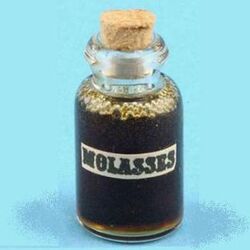| Jar of Molasses from the Boston Molasses Disaster | |
|---|---|

| |
| "Molasses, waist deep, covered the street and swirled and bubbled about the wreckage ... Here and there struggled a form—whether it was animal or human being was impossible to tell. Only an upheaval, a thrashing about in the sticky mass, showed where any life was ... Horses died like so many flies on sticky fly-paper. The more they struggled, the deeper in the mess they were ensnared. Human beings—men and women—suffered likewise". | |
|
Origin |
The Boston Molasses Disaster (Flood) |
|
Type |
Jar of Molasses |
|
Effects |
When opened it will cover you in its sticky residue & drown you in molasses. If not contained it will move on from person to person. |
|
Downsides |
Effect(s) |
|
Activation |
Opening The Jar |
|
Collected by |
Dylan Striver |
|
Section |
|
|
Aisle |
680-2968 |
|
Shelf |
67964-7806-467 |
|
Date of Collection |
January 12th 2014 |
| [Source] | |
Origin[]
The disaster occurred at the Purity Distilling Company facility on January 15, 1919. The temperature had risen above 40 °F (4.4 °C), climbing rapidly from the frigid temperatures of the preceding days. At the time, molasses was the standard sweetener in the United States. At about 12:30 in the afternoon near Keany Square, at 529 Commercial Street, a molasses tank 50 ft (15 m) tall, 90 ft (27 m) in diameter and containing as much as 2,300,000 US gal (8,700 m3) collapsed. Witnesses stated that as it collapsed, there was a loud rumbling sound, like a machine gun as the rivets shot out of the tank, and that the ground shook as if a train were passing by.
The collapse unleashed a wave of molasses 25 feet (7.6 m) high at its peak, moving at 35 miles per hour (56 km/h). The molasses wave was of sufficient force to damage the girders of the adjacent Boston Elevated Railway's Atlantic Avenue structure and tip a railroad car momentarily off the tracks. Author Stephen Puleo describes how nearby buildings were swept off their foundations and crushed. Several blocks were flooded to a depth of 2 to 3 feet (60 to 90 cm). The Boston Globe reported that people "were picked up by a rush of air and hurled many feet." Others had debris hurled at them from the rush of sweet-smelling air. A truck was picked up and hurled into Boston Harbor. Approximately 150 were injured; 21 people and several horses were killed—some were crushed and drowned by the molasses. The wounded included people, horses, and dogs; coughing fits became one of the most common ailments after the initial blast. In a 1983 article for Smithsonian, Edwards Park wrote of one child's experience: Anthony di Stasio, walking homeward with his sisters from the Michelangelo School, was picked up by the wave and carried, tumbling on its crest, almost as though he were surfing. Then he grounded and the molasses rolled him like a pebble as the wave diminished. He heard his mother call his name and couldn't answer, his throat was so clogged with the smothering goo. He passed out, then opened his eyes to find three of his four sisters staring at him.
Effects[]
When opened it will cover you in its sticky residue & drown you in molasses. If not contained it will move on from person to person. The only way of neutralizing it is to have it crawl into the jar.
